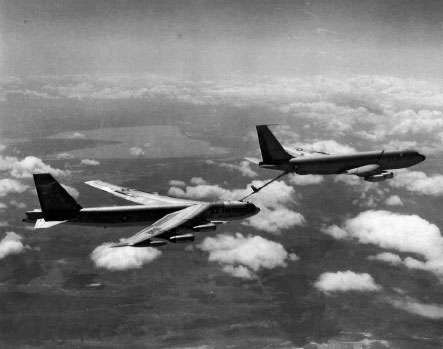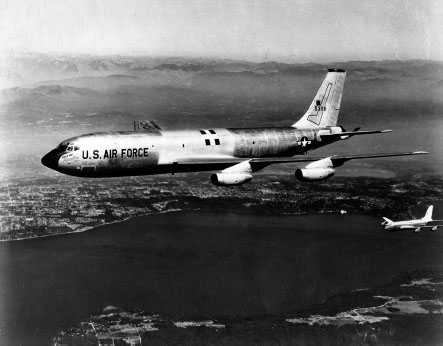Mayday Over Wichita (8 page)
Read Mayday Over Wichita Online
Authors: D. W. Carter


B-52 on flight line with crew.
22
nd
ARW History Office
.

KC-135 refuels a B-52.
22
nd
ARW History Office
.
T
HE
U
NVEILING
On Saturday, May 15, 1954, just two days before the historic
Brown v. Board of Education
decision was handed down by the Supreme Court, desegregating public schools in America, the Dash-80 was unveiled by Boeing Aircraft Company at its factory in Renton, Washington.
130
The air force had expressed an interest in a jet tanker, and the Dash-80 was the prototype for the commercial 707 and the KC-135. After its first flight on July 15, 1954, by test pilot Tex Johnston, it was clear that the Dash-80 prototype was going to be a success.
131
With the end of a brief contract dispute concerning which company would be allowed to build the new tanker for the air force, the Pentagon finally announced it would give the contract to Boeing in March 1955. The air force ordered three hundred KC-135s to be built at a total cost of $700 million.
132
At last, the air force would have the jet tanker that could meet its future and present needs. A commanding sight, weighing 297,000 pounds, the massive KC-135 had four P&W J57 turbojet engines with 13,750 pounds of thrust, a wingspan of 130 feet and ten inches, and a top speed of six hundred miles per hour with a range of approximately five thousand miles. It could accommodate four crew members and eighty troops with its large cargo deck. But most importantly, the KC-135 could transport more than thirty-one thousand gallons of jet fuel (double what the KC-97 tanker ever could) and deliver it with its telescoping flying boom.
133
It was the most efficient and capable refueling machine ever made up to that point, an impeccable force multiplier. As historian Steven L. Rearden noted, when SAC gained the advantage of acquiring three hundred KC-135 jet tankers to refuel the B-52s, it “could claim a
truly
global reach.”
134

Aircraft 55-3118 (the first KC-135) rolls out of the Boeing plant in Renton.
22
nd
ARW History Office
.
C
OMPLICATIONS OF
A
ERIAL
R
EFUELING
Despite the advances in technology, airborne refueling was, and continues to be, a dangerous task. It is a meticulous operation requiring a high level of skill from both the pilots and the boom operators. Boyne went on to describe the many variables when attempting aerial refueling:
Consider the case of the KC-135 and the B-52. The KC-135, cruising at 250 knots indicated and weighing some 300,000 pounds (of which perhaps 150,000 was highly flammable jet fuel), was physically connected, by a tube that averaged about 40 feet long, to the B-52, itself weighing more than 450,000 pounds, flying at the same speed, and perhaps carrying a number of nuclear weapons. Add to this picture of mass and momentum such factors as the dark of night, turbulent weather, and the prospect of combat, and you have all the elements of a genuine white-knuckle drama
.
135

Aircraft 55-3118 taking off.
22
nd
ARW History Office
.

Aircraft 55-3118 in flight.
22
nd
ARW History Office
.
Aware of the dangers, Boeing worked tirelessly to ensure the success of its effective and lucrative machine. Perfected from its prototype, the Dash-80, the KC-135 jet tanker first took flight on August 31, 1956, and was assimilated into SAC the following year.
136
Boeing produced a total of 820 KC-135s (732 of which were KC-135A models) before it closed production in 1966.
137
From then on, the primary mission of the KC-135 was, as it remains today, to refuel long-range strategic bombers. Operation Lucky Number, though ending in misfortune, was a byproduct of that mission. It epitomized the necessity of military preparedness, the challenges of mastering this new technology and the heavy toll it could inflictâon both civilians and military membersâwhen fulfilling that need.
The symbiotic relationship between the City of Wichita and the air force existed long before the Piatt Street crash. When Rock Roadânow a bustling, paved thoroughfare in Wichitaâwas little more than a “rock road,” it existed. When aviation manufacturing in Wichita exploded with the onset of World War II, it existed. When the air force first considered establishing a base near Wichita Boeing facilities, in February 1951, it existed. And when the City of Wichita received a $9.4 million check from the U.S. government for it to acquire the Wichita Municipal Airport the following yearâwhich later became McConnell AFBâits presence was cemented.
138
The air force needed Wichita; Wichita needed the air force. Nothing has changed.
7
INSIDE THE COCKPIT
All I could think of was that poor pilot is going downâ¦
âO. B. Hill, Eyewitness
, 1965
139
The engines cried out in agony from the heavy load. The metal fuselage groaned and creaked, stressed under the tension of the skyward climb. Stiff jerks, created by turbulence, shoved the pilots around the cockpit. The flight felt uncontrolled, unfamiliar, unresponsive and violent. Staying in the air seemed impossible. The needle on the altitude gauge refused to rise. Warning bells and alarms blared from the control board. Rooftops, cars, trees and city streetsânormally tiny objects when in flightâwere plainly distinguishable. The pilots began draining the fuel to increase liftâcausing a thick, white vapor trail to cut across the Wichita sky, outlining the dying plane like chalk on a blackboard. Screams of “Mayday!” shrieked into the ears of aircraft controllers back at McConnell. Then the KC-135 turned belly up and headed for a nose dive at 20
th
and Piatt. Just four brutal minutes would change the history of Kansas forever.
At first, Wichitans, going about their normal routines that Saturday morning, would have hardly noticed a sight so commonâanother KC-135 ascending into the sky. One such onlooker, Colonel James Trask, the Commander of McConnell AFB, remembered, “It was a clear, windless dayâ¦I thought it was a wonderful day to fly.”
140
Nothing looked unusual. The climb appeared ordinaryâspeed, altitude, flap retraction, gear upâbut somewhere between five hundred and one thousand feet, three minutes into flight, Captains Szmuc and Widseth were warring with the doomed plane. Raggy 42, loaded with jet fuel and skimming very low, soon created panic just above the heavily populated area of northern Wichita.

Left side of a KC-135 Model A cockpit.
22
nd
ARW History Office
.
A 707 commercial airlinerâalmost identical in appearance to its military counterpart, the KC-135âdeparted Wichita Municipal Airport only minutes before Raggy 42. The 707 was carrying one hundred passengers. The first reports of a crash subsequently caused many to believe that the 707 went down, confusing it with the KC-135.
141
That misinformation was quickly dispelled, though, because several witnesses, many of whom were pilots, recalled seeing a plane lift off from the McConnell runway and begin a left turn before crashing. Within minutes, every SAC base in the United States knew Raggy 42 had crashed. Lieutenant General David Wade, the Commander of the Second Air Force, received word of the crash at his office in Shreveport, Louisiana. He boarded an air force jet and was in Wichita one hour later.
142
Boeing investigators, too, were on scene before one hour had passed.
F
UEL
J
ETTISONING
On the evening of January 16, 1965, the
Wichita Beacon
recorded numerous eyewitness accounts of the plane's bizarre behavior after leaving the runwayâbehavior for which we now have an explanation. With over seven hundred flying hours as a pilot, Thomas Klem ascertained that Raggy 42 was indeed displaying some unusual behavior. Klem had just taken his son to wrestling practice at Wichita Heights High School and was driving south on Oliver Street when he observed a contrail from Raggy 42. Puzzled, Klem wondered, “Why was there a vapor trail at an altitude of one thousand feet?”
143
The reasoning soon became apparent. As the plane jerked violently back and forth, the crew made the conscious decision to begin jettisoning fuel. There are two reasons pilots make such a decision: to lighten the plane in order to gain lift or to lighten the plane in order to avoid an overweight landing.
